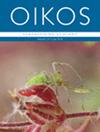三个地中海灌木物种的根系觅食策略和生态位隔离
IF 3
2区 环境科学与生态学
Q2 ECOLOGY
引用次数: 0
摘要
灌木通常适应土壤资源有限的压力环境,因此根系是其生物成功的基础。然而,根的测量数据很难收集,尤其是在野外条件下和个体水平上。在这项研究中,我们收集了西班牙中部地中海灌木林中三种灌木物种的 23 个个体的细根生物量的三维分布数据,这三种灌木物种分别是:岩蔷薇 Cistus ladanifer、迷迭香 Salvia rosmarinus 和毛果扫帚 Cytisus striatus。我们的目标是确定植物采用的觅土策略。我们假设,植物会表现出稳定的生态位差异,以解释地中海灌木地植物生物多样性高的特点,并假设它们会遵循博弈论模型的预测,即根系的开发性隔离行为具有领地性,但也会在靠近茎干的地方过度增殖根系,上演根系的公地悲剧。我们发现,三分之二到四分之三的生物量在地下,系统的生产力大约为每年 500-600 克 C m-2。只有迷迭香植物与邻居的竞争符合开发性隔离的预测。扫帚属植物的根系最浅、分布最广,但它们的根系范围明显缩小,与竞争邻居的根系范围相近。岩蔷薇的根系深而窄,避免了与邻居的广泛重叠,但似乎对竞争压力水平没有反应。灌木似乎在不同的土壤深度对根系进行分层,这支持了生态位隔离假说。本文章由计算机程序翻译,如有差异,请以英文原文为准。
Root foraging strategies and niche segregation of three mediterranean shrub species
Shrubs are usually adapted to stressful environments in which soil resources are limited, and thus, roots are fundamental for their biological success. However, root measures are challenging to collect, especially in field conditions and at the individual level. For this study, we collected data on the three‐dimensional distribution of fine root biomass of twenty‐three individuals belonging to three shrub species in a mediterranean shrubland in central Spain: gum rockrose Cistus ladanifer , rosemary Salvia rosmarinus , and hairy‐fruited broom Cytisus striatus . Our goal was to determine the soil‐foraging strategies adopted by the plants. We hypothesized that plants would show stabilizing niche differences explaining the high plant biodiversity characteristic of mediterranean shrublands and that they would follow the game theory model's prediction of exploitative segregation of roots behaving territorially but also over‐proliferating roots close to their stem and engaging in a root tragedy of the commons. We found that two‐thirds to three‐fourths of the biomass was belowground, and the system's productivity was roughly 500–600 g C m−2 year−1 . Only rosemary plants competed with neighbors following the exploitative segregation predictions. Broom plants had the shallowest and most widespread root systems but significantly reduced their root range toward competing neighbors. Gum rockrose presented deep, narrow root systems avoiding extensive overlap with neighbors but did not appear to respond to competitive pressure levels. Shrubs appeared to stratify their roots at different soil depths, supporting the niche segregation hypothesis.
求助全文
通过发布文献求助,成功后即可免费获取论文全文。
去求助
来源期刊

Oikos
环境科学-生态学
CiteScore
6.20
自引率
5.90%
发文量
152
审稿时长
6-12 weeks
期刊介绍:
Oikos publishes original and innovative research on all aspects of ecology, defined as organism-environment interactions at various spatiotemporal scales, so including macroecology and evolutionary ecology. Emphasis is on theoretical and empirical work aimed at generalization and synthesis across taxa, systems and ecological disciplines. Papers can contribute to new developments in ecology by reporting novel theory or critical empirical results, and "synthesis" can include developing new theory, tests of general hypotheses, or bringing together established or emerging areas of ecology. Confirming or extending the established literature, by for example showing results that are novel for a new taxon, or purely applied research, is given low priority.
 求助内容:
求助内容: 应助结果提醒方式:
应助结果提醒方式:


